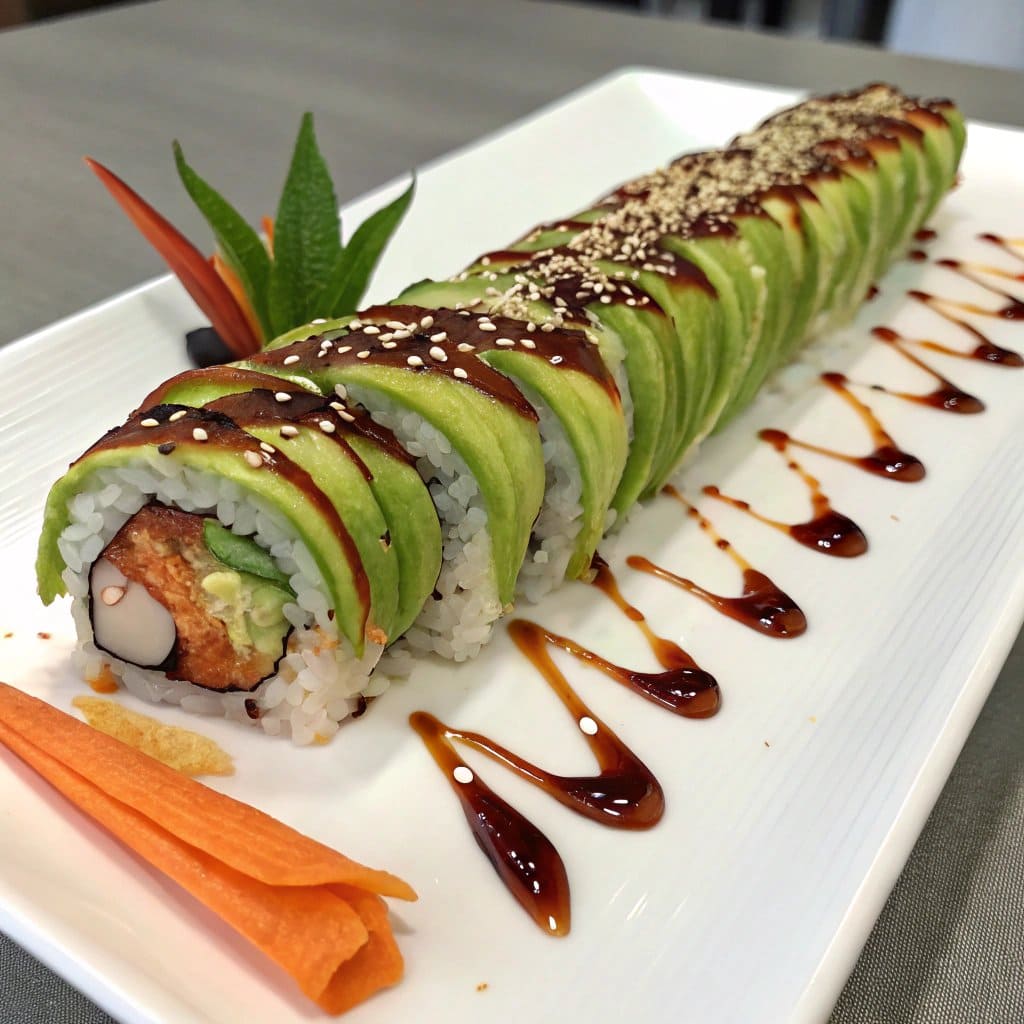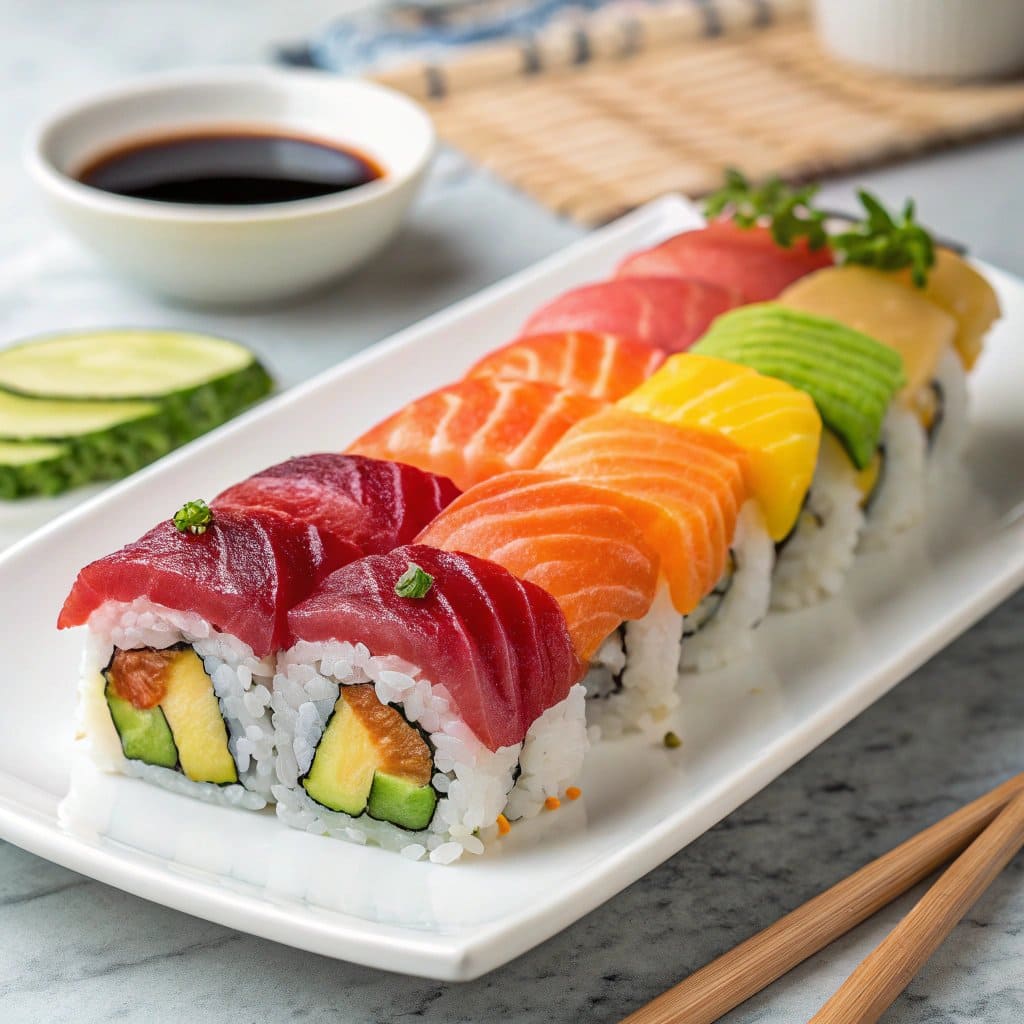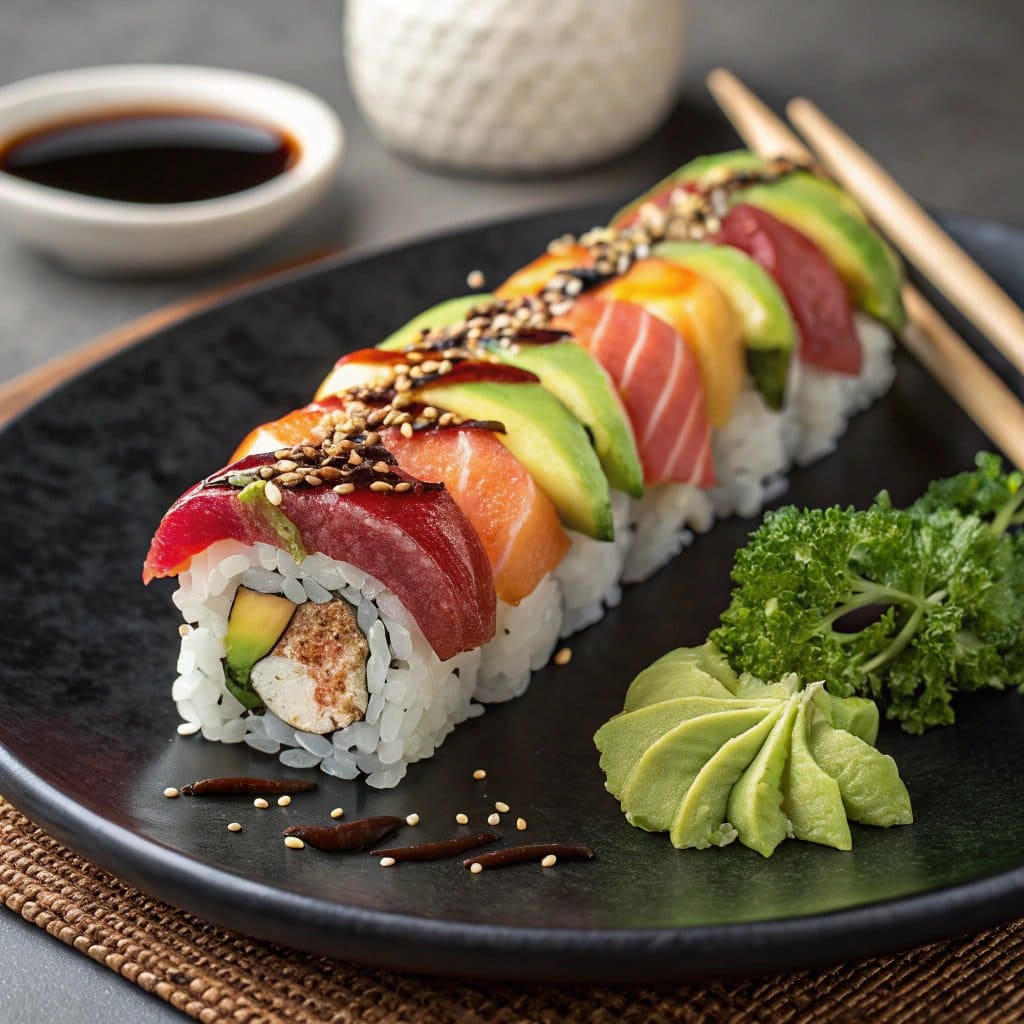The Difference Between Rainbow Roll and Dragon Roll: Sushi is a favorite dish around the world, known for its unique flavors and beautiful presentation. Among the many types of sushi rolls, the Rainbow Roll and Dragon Roll are two popular choices. Both are colorful, packed with flavor, and have their own unique twists.
In this article, we’ll dive into the details of these two iconic rolls. You’ll learn what makes each one special, their key ingredients, and how they differ. Whether you’re new to sushi or a seasoned fan, by the end of this article, you’ll know which roll suits your taste buds best.
Table of Contents
What is a Rainbow Roll?
The Components of a Rainbow Roll
A rainbow roll is a sushi roll known for its vibrant and colorful appearance. It’s essentially a California roll on the inside, featuring:
- Imitation crab meat or real crab: A sweet, tender filling.
- Avocado: Adds creaminess.
- Cucumber: Provides crunch and freshness.
The magic of the rainbow roll happens on the outside, where thin slices of sashimi—such as tuna, salmon, yellowtail, or shrimp—are layered over the roll, creating a “rainbow” effect.
Flavor Profile
The rainbow roll offers a light, fresh taste. The combination of creamy avocado, sweet crab, and savory raw fish creates a balanced flavor that sushi beginners and experts alike can enjoy.
When to Choose a Rainbow Roll
- If you love raw fish and want a roll with a variety of flavors.
- When you’re looking for something light and colorful to share.
What is a Dragon Roll?

The Components of a Dragon Roll
The dragon roll gets its name from its creative design, often crafted to resemble a dragon. It usually contains:
- Eel (unagi) or shrimp tempura: Provides a sweet, smoky, and slightly crispy filling.
- Cucumber: Adds a refreshing crunch.
- Avocado: Thin slices on top create a “scaly” appearance.
Some dragon rolls are drizzled with eel sauce (unagi sauce), a sweet and savory glaze that enhances the overall flavor.
Flavor Profile
The dragon roll offers a bold and rich taste, dominated by the sweet smokiness of the eel and the creamy texture of the avocado. The eel sauce adds an extra layer of sweetness, making it an indulgent treat.
When to Choose a Dragon Roll
- If you prefer cooked sushi or rich, smoky flavors.
- When you want a sushi roll with a dramatic and artistic presentation.
Rainbow Roll vs. Dragon Roll: A Side-by-Side Comparison
To help you better understand the differences between the rainbow roll and the dragon roll, let’s break down their key characteristics:
| Feature | Rainbow Roll | Dragon Roll |
|---|---|---|
| Base Roll | California roll (imitation crab, avocado, cucumber) | Eel roll or shrimp tempura roll |
| Toppings | Assorted sashimi slices (e.g., tuna, salmon, yellowtail) | Avocado slices arranged like scales |
| Primary Protein | Raw fish (sashimi) | Cooked eel or shrimp tempura |
| Sauce | Optional soy sauce or light drizzle | Eel sauce (sweet and savory) |
| Appearance | Bright and colorful, like a rainbow | Green and textured, resembling a dragon |
| Flavor Profile | Fresh, light, and creamy | Rich, smoky, and bold |
| Popularity | Loved by sashimi enthusiasts | A favorite for those who prefer cooked sushi |
Which Roll is Healthier?
Both rainbow rolls and dragon rolls can be healthy options, but their nutritional profiles vary based on their ingredients:
Rainbow Roll: The Fresh and Light Choice

- Calories: Generally lower in calories, especially without added sauces.
- Nutrients: Rich in omega-3 fatty acids from sashimi, as well as fiber and vitamins from avocado and cucumber.
- Great For: Those looking for a lighter option that highlights the freshness of raw fish.
Dragon Roll: The Rich and Indulgent Option
- Calories: Higher in calories due to the eel, tempura, and eel sauce.
- Nutrients: Provides a good dose of protein and healthy fats from eel and avocado but can include more sugar and sodium due to the sauce.
- Great For: Sushi lovers seeking a more indulgent and flavorful experience.
Preparation Techniques
How Chefs Make a Rainbow Roll
Creating a rainbow roll requires skill in slicing sashimi thinly and evenly to layer on top of the base California roll. Here’s a basic step-by-step:
- Prepare the California roll: Spread sushi rice over nori (seaweed) and add the crab, avocado, and cucumber inside.
- Roll it up tightly using a bamboo mat.
- Top the roll with slices of sashimi in alternating colors to create the “rainbow” effect.
- Garnish with sesame seeds, tobiko (fish roe), or a drizzle of spicy mayo if desired.
How Chefs Make a Dragon Roll
Making a dragon roll involves both creativity and precision to achieve its iconic look:
- Prepare the base roll: Add eel or shrimp tempura with cucumber inside.
- Roll it up and then layer thinly sliced avocado on top, carefully arranging it to resemble scales.
- Drizzle the roll with eel sauce for flavor and shine.
- Garnish with sesame seeds, tempura flakes, or even edible garnishes like carrot slices shaped like dragon heads.
Popular Variations of Rainbow and Dragon Rolls
Both rainbow rolls and dragon rolls are highly customizable, with chefs and sushi enthusiasts creating delicious variations. Here are some of the most popular twists on these iconic rolls:
Rainbow Roll Variations
- Tropical Rainbow Roll
- Features slices of mango or kiwi instead of traditional sashimi.
- Adds a sweet and tangy flavor, perfect for those who enjoy fruity sushi.
- Spicy Rainbow Roll
- Includes spicy tuna or spicy mayo inside for an extra kick.
- Topped with slices of fish that pair well with spicy flavors, like salmon or yellowtail.
- Vegetarian Rainbow Roll
- Swaps sashimi for vibrant vegetables like bell peppers, carrots, and avocado.
- A colorful and fresh option for non-meat eaters.
- Mini Rainbow Roll
- Smaller versions of the classic rainbow roll, perfect for kids or those who want bite-sized portions.
Dragon Roll Variations
- Spicy Dragon Roll
- Adds a spicy element with chili sauce or spicy mayo inside or on top.
- Often includes jalapeños for an extra layer of heat.
- Golden Dragon Roll
- Uses mango slices or sweet potato tempura on top, creating a golden appearance.
- Paired with a drizzle of honey or teriyaki sauce for a sweet and savory taste.
- Black Dragon Roll
- Topped with squid ink-infused rice or black sesame seeds for a dramatic look.
- Filled with shrimp tempura and drizzled with a thicker eel sauce.
- Crunchy Dragon Roll
- Includes tempura flakes or crispy fried onions on top for added crunch.
- Balances textures with creamy avocado and smoky eel.
Tips for Choosing the Right Roll
Here are some pointers to help you decide between a rainbow roll and a dragon roll based on your preferences:
- Go for a Rainbow Roll If:
- You enjoy the fresh taste of sashimi.
- You prefer lighter sushi options with minimal sauces.
- You like a visually colorful and vibrant presentation.
- Pick a Dragon Roll If:
- You love rich, bold flavors with cooked ingredients.
- You enjoy sweet and savory combinations, like eel with eel sauce.
- You want a sushi roll with a dramatic, artistic appearance.
More inspiring eats you can’t miss:
How to Make the Perfect Sea food Boil: A Step-by-Step Guide
Simple pastina soup recipe That Will Blow Your Mind!
How to Make the Perfect burger bowl: A Step-by-Step Guide
FAQs About Rainbow and Dragon Rolls
1. Are Rainbow Rolls Raw or Cooked?
Rainbow rolls are mostly raw because they are topped with sashimi. However, the filling inside (like imitation crab) is cooked.
2. Is the Dragon Roll Spicy?
A classic dragon roll isn’t spicy, but spicy variations include chili sauce or spicy mayo for heat.
3. Which Roll is Easier to Make at Home?
The dragon roll is slightly easier to make at home since it involves cooked ingredients like eel or shrimp. Rainbow rolls require high-quality sashimi and more advanced slicing skills.
4. Can I Order These Rolls Without Certain Ingredients?
Yes, sushi chefs can often customize rolls. For instance, you can ask to swap raw fish in a rainbow roll with cooked ingredients or omit eel in a dragon roll.
5. What Drinks Pair Best With These Rolls?
- Rainbow rolls pair well with light beverages like green tea or sake.
- Dragon rolls complement richer drinks like plum wine or dark beer.
6. Are There Vegan Versions of These Rolls?
Yes! Many restaurants offer vegan alternatives by replacing seafood with vegetables, tofu, or plant-based proteins.
Conclusion: Choosing Between Rainbow and Dragon Rolls
Sushi is more than just a meal—it’s an experience of flavors, textures, and artistry. Both the rainbow roll and dragon roll offer unique takes on this culinary art form, appealing to different tastes and preferences.
- The rainbow roll shines with its colorful sashimi toppings, offering a fresh, light, and visually stunning sushi option. It’s perfect for sashimi lovers or those looking for a variety of raw fish flavors in one roll.
- The dragon roll, with its rich, smoky eel or shrimp tempura and creamy avocado, is an indulgent and bold choice. Its dramatic design and flavorful toppings make it a favorite for anyone who prefers cooked sushi with a sweet-savory twist.
Whether you’re dining at a sushi bar or experimenting with rolls at home, these two iconic sushi options are bound to delight. The choice ultimately depends on your palate: Do you lean toward the vibrant freshness of raw fish or the comforting richness of cooked ingredients? Either way, you can’t go wrong.
Explore More Sushi Adventures
If you enjoyed learning about rainbow rolls and dragon rolls, why not try:
- Tiger Rolls: Another sushi roll with a bold and playful presentation.
- Spicy Tuna Rolls: A classic for heat lovers.
- Veggie Rolls: A healthy and colorful sushi option for plant-based diets.
Ready to explore the world of sushi? Grab your chopsticks and enjoy the flavors of Japan, one roll at a time! 🍣

